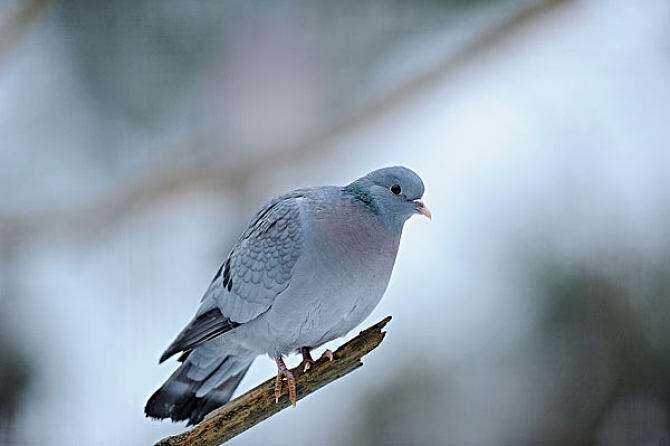Green Imperial-pigeon
IUCN
LCBasic Information
Scientific classification
- name:Green Imperial-pigeon
- Scientific Name:Wood pigeon, common wood pigeon,Columba palumbus,Green Imperial-pigeon
- Outline:Landfowl
- Family:P.Order P.family P.genus
Vital signs
- length:40-45cm
- Weight:530-625g
- lifetime:About 16 years
Feature
Similar in size to the wild pigeon, the body is gray, with a white collar, and the wings have white stripes
Distribution and Habitat
It is distributed in Bangladesh, Bhutan, Brunei, Cambodia, China, India, Indonesia, Lao People's Democratic Republic, Malaysia, Myanmar, Philippines, Singapore, Sri Lanka, Thailand, Vietnam.
It is a resident bird that inhabits mountain broad-leaved forests, mixed forests and coniferous forests, and occasionally occurs in forest plains.
Appearance
The plumage of the male and female birds is similar, with a dull gray color throughout the head and neck, a lighter color on the forehead and throat, and a green or copper-colored metallic luster on the lower part of the nape. There is a yellowish spot on the side of the neck, which is one of its unique features. The lower neck and underside of the yellow spots are metallic green with a purple sheen, the upper back, shoulders and upper wing coverings are pale earthy brown, and the wings are grayish brown with two diagonal white bands. The lower back, loin and upper tail coverings are dark gray, the tail feathers are dark brown, with a broad gray cross band in the middle, the chest is grape pink, gradually lightening down to the abdomen, the two sides and lower tail coverings are also pigeon gray, the lower surface of the tail feathers are black, and the middle has a white cross band, which is one of its main characteristics. The iris is yellowish-white to yellowish-yellow, the base of
Details
There are 6 subspecies of Green Imperial pigeon. Columba palumbus casiotis (Columba palumbus casiotis) is the only one in China. It is found in Kashgar and Tianshan Mountains in western Xinjiang. Rare resident bird.

Zebra pigeons like to travel in groups, especially during the non-breeding season. Temperament timid and alert, the speed of flight is relatively slow, appears unhurried. When resting, he likes to live in tall trees in open areas, but stays and hides on thick low branches. Mainly to plant acorn, mulberry and other fruits, seeds and grains for food, but also eat plant young leaves and buds. They often forage among trees and bushes, as well as on the ground and in the fields. Loud flutter flutter during takeoff. Show flight is when the two wings reach the highest point and then dive down, or glide with the two wings half together. Group activity. Foraging on agricultural fields.
The pigeon's call is a cooing sound with a stressed second syllable and a drag of "cu-cooh-cu", "coo-coo".
The breeding period is from April to July. They often nest in pairs. They usually nest in secluded, unfrequented dense forests. The nest is usually placed on the branch of the tree, near the branch of the trunk. The structure of the nest is loose and simple, mainly composed of a few thin dead branches. There are usually two eggs laid in each clutch, and the eggs are white in color and 37-44×26-35 mm in size. Male and female birds take turns incubating eggs. Incubation period is 17 days. The chicks are late sex and fly out of the nest after 20-35 days. The reproductive behavior of the zebra pigeon can be observed causally. Because over the course of a few weeks, the few signals exchanged between spouses modulated these behaviors. In fact, careful research has shown that it is nothing more than a physiological drama played out through precise communication arrangements, external stimuli, hormonal activity, and so on. The whole cycle takes six to seven weeks.
Once the adult male and female are placed together in a cage with nesting material, the male begins courting, bowing, nodding and cooing. After a few hours, they choose a concave nesting base (a bowl in the lab) and crouch in it while making a special call. Soon the two pigeons brought their nesting materials to the base and used them to build a simple nest. After a few days of nesting, the female's attachment to the nest increased and she soon laid two eggs. After that, the two pigeons took turns sitting on the eggs.
Experiments have shown that mating itself stimulates the pituitary gland to secrete gonadotropin. This substance in turn promotes estrogen, which causes nesting behavior and the production of progesterone, and hatching behavior is the result of progesterone. Another pituitary hormone is prolactin, which causes the growth of the crop epithelium. The shed epithelium is fed to the young pigeons like "milk". Prolactin also maintains hatching behavior. When the chicks reach two to three weeks of age, the parents begin to abandon them, and soon after, the parents begin a new hormone-behavioral cycle. In the lab, this process continues for years.
Listed on the International Union for Conservation of Nature (IUCN) 2013 Red List of Threatened Species ver3.1 - Not Threatened (LC).
It is listed in the second level of the List of China's National Key Protected Wildlife.
Protect wild animals and eliminate wild meat.
Maintaining ecological balance is everyone's responsibility!








